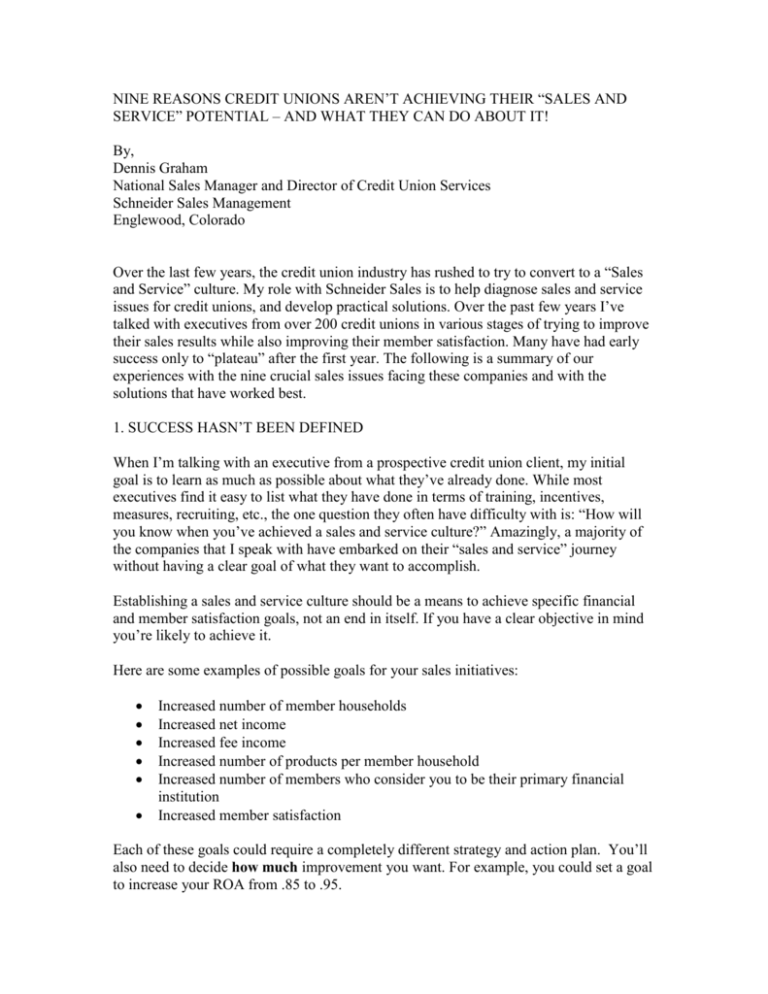TEN REASONS WHY CREDIT UNIONS AREN`T ACHIEVING THEIR
advertisement

NINE REASONS CREDIT UNIONS AREN’T ACHIEVING THEIR “SALES AND SERVICE” POTENTIAL – AND WHAT THEY CAN DO ABOUT IT! By, Dennis Graham National Sales Manager and Director of Credit Union Services Schneider Sales Management Englewood, Colorado Over the last few years, the credit union industry has rushed to try to convert to a “Sales and Service” culture. My role with Schneider Sales is to help diagnose sales and service issues for credit unions, and develop practical solutions. Over the past few years I’ve talked with executives from over 200 credit unions in various stages of trying to improve their sales results while also improving their member satisfaction. Many have had early success only to “plateau” after the first year. The following is a summary of our experiences with the nine crucial sales issues facing these companies and with the solutions that have worked best. 1. SUCCESS HASN’T BEEN DEFINED When I’m talking with an executive from a prospective credit union client, my initial goal is to learn as much as possible about what they’ve already done. While most executives find it easy to list what they have done in terms of training, incentives, measures, recruiting, etc., the one question they often have difficulty with is: “How will you know when you’ve achieved a sales and service culture?” Amazingly, a majority of the companies that I speak with have embarked on their “sales and service” journey without having a clear goal of what they want to accomplish. Establishing a sales and service culture should be a means to achieve specific financial and member satisfaction goals, not an end in itself. If you have a clear objective in mind you’re likely to achieve it. Here are some examples of possible goals for your sales initiatives: Increased number of member households Increased net income Increased fee income Increased number of products per member household Increased number of members who consider you to be their primary financial institution Increased member satisfaction Each of these goals could require a completely different strategy and action plan. You’ll also need to decide how much improvement you want. For example, you could set a goal to increase your ROA from .85 to .95. 2. THE EMPHASIS IS ON CROSS SELLING, NOT SALES EFFECTIVENESS To have a successful sales and service culture it’s important to focus on the overall effectiveness of selling in meeting corporate goals, not just on cross selling. A high household cross-sell ratio is just as likely to result in low profitability as high profitability and many of the best sales opportunities are simple solution sales opportunities. A good example is a credit union that spent a lot of effort on selling additional products to each member who walked in the door, yet allowed their call center to have 100 mortgage inquiries A WEEK go unanswered due to lack of staff in that area. 3. THE RIGHT MEASURES AREN’T IN PLACE Many credit unions have worked hard to develop systems to measure referrals and core product sales. Almost every credit union measures operations efficiency. Surprisingly, few credit unions measure employee and member satisfaction or the effective use of sales process, the leading indicators of sales productivity. These measures should be included as part of a balanced scorecard approach to measures and performance management. It is easy to put so much emphasis on immediate transactional sales that your member or employee satisfaction begins to drop or that long term sales effectiveness built through the continuing use of the organization’s preferred sales process is sacrificed for short term sales production. 4. LACK OF PRODUCT KNOWLEDGE This is a real surprise in an industry known for excellent training programs and being “staff friendly”. Yet in virtually every credit union where we’ve done an assessment, the line people are crying out for product knowledge. Placing your product manual on the intranet isn’t the solution because employees need to know how to apply your products to member situations. The solution is to provide member-focused product training and product mastery testing at the corporate level and to make line managers accountable for the product knowledge of their staff in their appraisals. 5. MANAGERS ARE OVERRELIANT ON INCENTIVES Incentives are the best excuse in the world not to manage. “If we design the right incentive plan, people will know what to do, and do it”. If it were only so! We’ve seen this perspective so often that we’ve coined the phrase “energized incompetence.” People are turned on by incentives, but without good supervision and good sales process their higher levels of activity aren’t well focused and the incentive dollars are often misspent. Here are some common issues with credit union incentive plans: They are too complex. The incentive will only be effective if the employees incented understand the goal and what they can do to be rewarded. They reward outcomes over which the person has no control or which cannot be measured. They are designed so only top performers can win and everyone else tunes out. They reward the wrong behavior. Often the programs incent the sale of a product instead of meeting a member’s need. One - shot programs are great to introduce a new product, but over time they lose their effectiveness and encourage your staff to offer products to unqualified prospects. They reward low levels of performance that could easily be achieved with good supervision and no incentives so they become viewed as “entitlements.” By definition, incentives should reward behavior above the norm or expected outcome. Incentives will never replace good supervision in influencing employee behavior and results. Our recommended approach is a “balanced scorecard” measurement and reward system that takes into account all the critical goals of the organization – not just sales volume results. 6. SUPERVISORS AREN’T COACHING “BEHAVIORS” Because of the credit union industry’s emphasis on employee development, credit union supervisors are often better coaches than their counterparts in other financial institutions. Yet we often see most coaching directed at results instead of at the specific of behaviors that produce those results. As a result, employees don’t know the specifics of how to improve their performance. A necessary first step toward providing more specific feedback to employees in observation coaching is to define a “Preferred Way of Selling” ® so that everyone in the organization understands the desired behaviors. 7. POOR FOCUS AND ACCOUNTABILITY AT THE MEMBER CONTACT AREA I often hear comments such as, “well, we got started and did some training, but then we lost our momentum,” or “There’s really no accountability for not selling around here.” FOCUS and ACCOUNTABILITY are the two critical components to a successful sales culture and a clearly defined sales process is the key to sustaining focus and accountability over the long haul. 8. POOR INTEGRATION OF SALES AMONG BUSINESS UNITS Clearly, your entire organization has to be in synch if you are going to be successful at sales. For example, if your member contact staff is going to be successful improving their sales results while also increasing member satisfaction, “back office” staff members in the organization also have to support those who serve members directly every day. If you’re going to provide seamless solutions to members and build referrals from one business unit to another, all business units will need to share common goals and share accountability for solution selling across business lines. All the components of effective sales and service need to be linked together both functionally and in goal setting. Top performing sales organizations have service level agreements between their departments and weekly accountability meetings among senior managers across business units. 9. THE RIGHT PEOPLE AREN’T IN PLACE IN THE RIGHT JOB ROLES A common complaint is, “we could be a lot more successful if we just had the right people”. More accurately, our national research of salespeople in the credit union industry with the Dr. Cliff Young at the University of Colorado Business School demonstrated that most credit unions may simply have the right people in the wrong job roles. For example, if you think of the evolution of most branch managers in credit unions, they ascended to their position by being one of the top operations people. Unfortunately, the characteristics that made them a top “ops” person are often in conflict with those that will make them a top sales coach or sales producer. One of our first tasks is to work with a new client to define what they want their people to do in each job role and to compare that to the behavioral characteristics required for success in each of the five sales, service and leadership roles that encompass virtually all front-line job roles in the credit union industry. Let’s use the branch manager position again as an example. Are they to be dedicated to working as a “teller leader” – perhaps in a small branch? Are they to work more as a “lead MSR” – in a slightly larger branch? Are they supposed to be business development people with outside calling responsibility? Are they to become licensed for insurance or brokerage products? Or are they to be full time managers and coaches? Or even worse, do we expect “all of the above?” In our four years of research with the University of Colorado, we’re learned that the behavioral competencies required for success in each of the job roles described above are dramatically different. It isn’t necessary to have the same model for each position at each location, but it is critical that everyone agree on the job role requirements for each position. Once you define what you want from a specific position you can develop a good “scorecard” to use in evaluating both the employees you have and any new candidates against those requirements. Research shows that only 1 in 4 people will be successful in any sales role, and many of those who could be successful are in the wrong sales role. Even more important, top performers in sales outperform low performers by 10 to 1! You’ll be amazed who will shine and how your employee turnover will decline when you place your employees in the right jobs to match their competencies. SUMMARY Achieving long-term, sustainable improvement in sales productivity, member satisfaction and employee satisfaction requires the integration of all the components of sales and service in one well-defined process that provides continuing FOCUS and ACCOUNTABILITY. In the absence of good sales process, credit unions can’t rely on training and incentives alone to get the job done.








